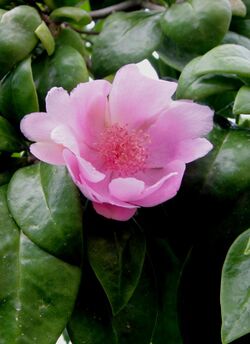Biology:Pereskia quisqueyana
| Pereskia quisqueyana | |
|---|---|

| |
| Scientific classification | |
| Kingdom: | Plantae |
| Clade: | Tracheophytes |
| Clade: | Angiosperms |
| Clade: | Eudicots |
| Order: | Caryophyllales |
| Family: | Cactaceae |
| Genus: | Pereskia |
| Species: | P. quisqueyana
|
| Binomial name | |
| Pereskia quisqueyana E.Ekman
| |
Pereskia quisqueyana, commonly known as the Bayahibe rose, is a species of cactus that is endemic to the Dominican Republic.[1] P. quisqueyana is one of only several cactus species which possess leaves. Its natural habitat includes subtropical or tropical dry forests that are found on the Southeast coast of Hispaniola; particularly around the town of Bayahibe, its namesake. It is critically endangered due to habitat loss.
The species was discovered by the France botanist, Henri Alain Liogier, in 1977. He named it quisqueyana, in honor of the Dominican Republic, which is also referred to as Quisqueya. Law 146-11 of the Dominican Republic, established the Bayahibe Rose as the national flower of the country and ensured its protection due to its endangered status.
Description
Pereskia quisqueyana is a dioecious cactus that resembles a shrub and reaches up to 6 metres (20 ft) in height. Its trunk is surrounded by groups of spines which erupt in bunches. Its succulent leaves are elliptical in shape and are a bright green color. The flower of the P. quisqueyana is pink in color and blooms from the ends of its branches. Its fruits are yellow and contain black seeds.
References
- ↑ PUCMM. "Pereskia Quisqueyana" (in Spanish). Archived from the original on 2011-05-26. https://web.archive.org/web/20110526185119/http://rsta.pucmm.edu.do/ciencias/arboretum/intro/website%20sub%20pages/Arboretum/area_2/pereskias/1-pereskias/body_1-pereskias.html. Retrieved 2010-09-24.
Wikidata ☰ Q291145 entry


